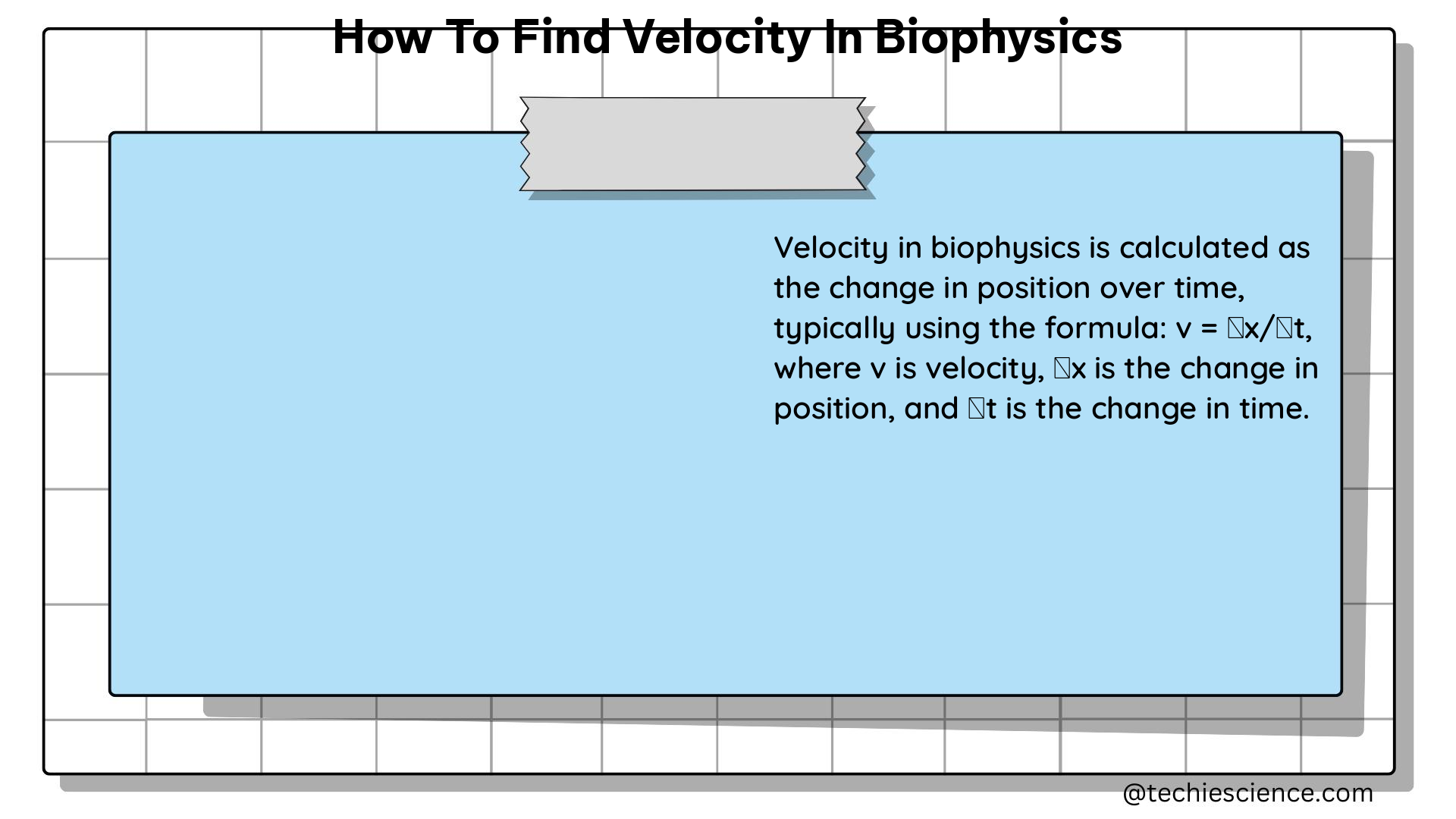Summary
Biophysics is a multidisciplinary field that combines the principles of biology and physics to study the physical aspects of living organisms. One of the fundamental quantities in biophysics is velocity, which is crucial for understanding various biological processes, from blood flow to cellular dynamics. In this comprehensive guide, we will explore several measurable and quantifiable methods to determine velocity in biophysics, including the Doppler shift method, AFM-based approaches, calibration techniques, and data table analysis.
Doppler Shift Method

The Doppler shift method is a widely used technique for measuring the velocity of blood flow in the human body. The principle behind this method is the Doppler effect, which describes the change in the observed frequency of a wave when the source and the observer are in motion relative to each other.
Doppler Shift Formula
The relationship between the Doppler shift frequency (Δf) and the velocity of the blood (v) is given by the following equation:
[
\Delta f = \frac{2v \cdot f_0 \cdot \cos \theta}{c}
]
where:
– Δf is the Doppler shift frequency
– v is the velocity of the blood
– f_0 is the transmitted frequency
– c is the velocity of sound in the medium
– θ is the angle between the ultrasound beam and the blood flow direction
Doppler Shift Example
Let’s consider an example where the transmitted frequency f_0 is 8 MHz, and the velocity of sound c in the medium is 1570 m/s. To calculate the velocity of the blood in an artery, we can rearrange the Doppler shift formula:
[
v = \frac{\Delta f \cdot c}{2 \cdot f_0 \cdot \cos \theta}
]
By measuring the Doppler shift frequency Δf and the angle θ between the ultrasound beam and the blood flow direction, we can determine the velocity of the blood in the artery.
AFM-Based Approaches
Atomic Force Microscopy (AFM) is a powerful tool in biophysics that allows for the measurement of biological forces and the viscoelastic properties of cells. Two key AFM-based approaches for determining velocity in biophysics are:
Force-Distance (FD) Curves
FD curves are generated by detecting the deflection of the AFM cantilever as it interacts with a sample. These curves can be quantified to measure the biological forces and viscoelastic properties of cells, which are directly related to their velocity and dynamics.
Fläschner et al.’s Setup
Fläschner et al. developed a setup that uses two parallel microcantilevers to measure the viscoelasticity of cells. In this setup, the master microcantilever is driven by a blue laser, while the motion of the slave microcantilever is read by a red laser. By analyzing the relative motion of the two cantilevers, the viscoelastic properties and, consequently, the velocity of the cells can be determined.
Calibration Methods
Calibration methods are essential in biophysics to obtain accurate measurements of various physical quantities, including velocity. One such method is the Fischer’s Calibration Approach.
Fischer’s Calibration Approach
Fischer’s Calibration Approach is used to determine the trap stiffness and conversion factor for dielectric beads of unknown size in a medium with unknown viscoelastic properties. By calibrating the system, researchers can accurately measure the velocity of the beads and, by extension, the velocity of the surrounding medium or cellular structures.
Data Table Analysis
In addition to the more advanced techniques, simple data table analysis can also be used to determine velocity in biophysics. The formula for calculating average speed is:
[
\text{Average Speed} = \frac{\text{Total Distance}}{\text{Total Time}}
]
Data Table Example
Consider a data table that records the distance and time for a person driving to school. By inputting the total distance and total time into the formula, you can calculate the average speed of the person’s commute.
Additional Considerations
- Velocity measurements in biophysics can be influenced by various factors, such as temperature, viscosity, and the presence of obstacles or boundaries.
- Proper calibration and control of experimental conditions are crucial to ensure the accuracy and reliability of velocity measurements.
- Combining multiple measurement techniques, such as Doppler shift and AFM-based approaches, can provide a more comprehensive understanding of velocity in complex biological systems.
- Numerical simulations and computational modeling can complement experimental methods to predict and analyze velocity in biophysical systems.
Conclusion
Determining velocity is a fundamental aspect of biophysics, as it provides crucial insights into the dynamics and function of living organisms. In this comprehensive guide, we have explored several measurable and quantifiable methods, including the Doppler shift technique, AFM-based approaches, calibration methods, and data table analysis. By understanding and applying these techniques, biophysicists can gain a deeper understanding of the physical processes that govern biological systems.
References:
- Biological Physics: Energy, Information, Life – Esalq
- Biophysical Approaches for Applying and Measuring Biological Forces – NCBI
- Calculating Speed and Velocity From a Data Table – YouTube
- Measurable Quantity – ScienceDirect Topics
- Biophysics Laboratory Exercises – University of Białystok
- Fläschner, G., Becker, B., Schierbaum, N., Schäfer, C., Lauster, D., Herrmann, A., & Merkel, R. (2016). Correlating Cellular Dynamics and Mechanical Properties of Cells Using a Two-Cantilever Technique. Biophysical Journal, 110(4), 947-955.
- Fischer, M., & Berg-Sørensen, K. (2007). Calibration of trapping force and response function of optical tweezers in viscoelastic media. Journal of Optics A: Pure and Applied Optics, 9(8), S239.

The lambdageeks.com Core SME Team is a group of experienced subject matter experts from diverse scientific and technical fields including Physics, Chemistry, Technology,Electronics & Electrical Engineering, Automotive, Mechanical Engineering. Our team collaborates to create high-quality, well-researched articles on a wide range of science and technology topics for the lambdageeks.com website.
All Our Senior SME are having more than 7 Years of experience in the respective fields . They are either Working Industry Professionals or assocaited With different Universities. Refer Our Authors Page to get to know About our Core SMEs.